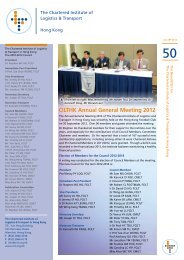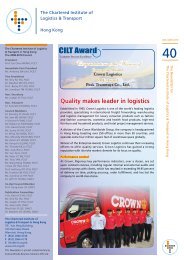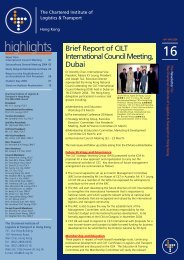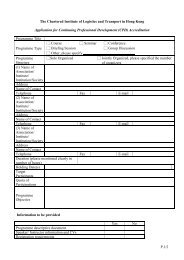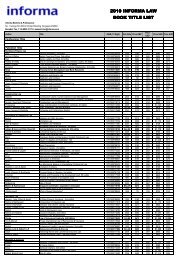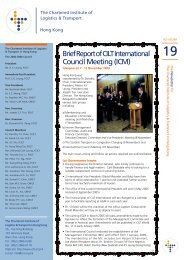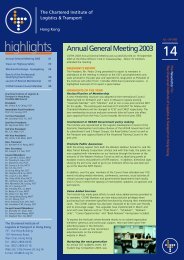to view file - The Chartered Institute of Logistics and Transport in ...
to view file - The Chartered Institute of Logistics and Transport in ...
to view file - The Chartered Institute of Logistics and Transport in ...
You also want an ePaper? Increase the reach of your titles
YUMPU automatically turns print PDFs into web optimized ePapers that Google loves.
CILTHK Newsletter issue 9<br />
DEC ~ FEB 2002<br />
highlights 09<br />
<strong>The</strong> Globalisation <strong>of</strong> Urban <strong>Transport</strong> 01<br />
Visit <strong>to</strong> Beij<strong>in</strong>g 06<br />
HK Maritime & <strong>Logistics</strong> Week 07<br />
CILTHK WebMail 08<br />
Position papers on transport issue 10-11<br />
<strong>Chartered</strong> <strong>Institute</strong> <strong>of</strong> <strong>Logistics</strong> &<br />
<strong>Transport</strong> <strong>in</strong> Hong Kong<br />
<strong>The</strong> 2000-2002 Council<br />
President :<br />
Mr. Pedro K.H. Ch<strong>in</strong>g, FCIT<br />
Immediate Past President :<br />
Pr<strong>of</strong>. C.K. Leung, FCIT<br />
1st Vice President :<br />
Mr. Jonathan H.G. Yu, FCIT<br />
2nd Vice President :<br />
Mr. Ng Kwok Wah, FCIT<br />
3rd Vice President :<br />
Mr. C.K. Mak, MCIT<br />
Hon. Treasurer :<br />
Mr. Kenneth Pang, MCIT<br />
Hon. Sectretary :<br />
Mr. Joseph Tsui, FCIT<br />
Council Members :<br />
Dr. Timothy D. Hau, FCIT<br />
Mr. David C.S. Ho, FCIT<br />
Dr. Hung W<strong>in</strong>g Tat, FCIT<br />
Mrs. Mir<strong>and</strong>a Leung, FCIT<br />
Mr. K.Y. Leung, FCIT<br />
Mr. Peter Y.C. Ng, FCIT<br />
Dr. L.H. Wang, FCIT<br />
Mr. Wong Man Kit, FCIT<br />
Pr<strong>of</strong>. Anthony Yeh, FCIT<br />
Mr. Sam Chow, MCIT<br />
Mr. Ip Chung Tim, MCIT<br />
Mr. Stephen K.M. Ip, MCIT<br />
Mr. Stephen M.K. Ip, MCIT<br />
Mr. Louis F.L. Ko, MCIT<br />
Mr. Timothy Li, MCIT<br />
Mr. Canice C.F. Mak, MCIT<br />
Mr. R.H. Noble, MCIT<br />
Mr. Tsang W<strong>in</strong>g Hang, MCIT<br />
Dr. S.C. Wong, MCIT<br />
Mr. Jonathan Yeung, MCIT<br />
Co-opt Council Members :<br />
Mr. Sunny Ho, MCIT<br />
Mr. Anthony Lau, MCIT<br />
Mr. Vic<strong>to</strong>r Mok, MCIT<br />
<strong>The</strong> Globalisation <strong>of</strong><br />
Urban <strong>Transport</strong><br />
Introduction<br />
Thank you for your <strong>in</strong>vitation <strong>to</strong> come <strong>to</strong> the<br />
University <strong>of</strong> Hong Kong <strong>to</strong> give this Dist<strong>in</strong>guished<br />
Lecture on the occasion <strong>of</strong> the 90 th Anniversary <strong>of</strong><br />
the Faculty <strong>of</strong> Eng<strong>in</strong>eer<strong>in</strong>g. Your university is quite<br />
young <strong>in</strong> Oxbridge terms but so <strong>to</strong>o is Imperial<br />
College. Its constituent parts go back only <strong>to</strong> the<br />
mid-19 th century <strong>and</strong> were founded by Pr<strong>in</strong>ce Albert,<br />
Queen Vic<strong>to</strong>ria’s husb<strong>and</strong>, certa<strong>in</strong>ly the best export<br />
Mr Tony Ridley<br />
from Germany that Brita<strong>in</strong> ever received! I leave<br />
aside my own ances<strong>to</strong>rs who came across the North Sea as illegal immigrants<br />
about 1500 years ago.<br />
I am particularly delighted <strong>to</strong> be here because <strong>of</strong> my former association with<br />
Hong Kong. <strong>The</strong> period 1975-80 was certa<strong>in</strong>ly one <strong>of</strong> the most excit<strong>in</strong>g <strong>and</strong><br />
successful times <strong>in</strong> my pr<strong>of</strong>essional career. We not only created <strong>and</strong> brought <strong>in</strong><strong>to</strong><br />
successful operation the first l<strong>in</strong>e for the now vastly larger HK Mass Transit<br />
Railway (MTR), but I believe that - with the HK Government <strong>of</strong> that time – we<br />
established a process for the successful pursuit <strong>of</strong> major urban public<br />
<strong>in</strong>frastructure projects.<br />
When Ir Joseph Chow, President <strong>of</strong> HKIE (<strong>of</strong> which I am proud <strong>to</strong> be a Fellow),<br />
<strong>in</strong>vited me <strong>to</strong> give the keynote address at a Shanghai-HK symposium on science<br />
<strong>and</strong> technology, it allowed me <strong>to</strong> s<strong>to</strong>p <strong>of</strong>f <strong>in</strong> Hong Kong on my way back <strong>to</strong><br />
S<strong>in</strong>gapore. I am currently, though briefly, the SMRT Pr<strong>of</strong>essor <strong>in</strong> <strong>Transport</strong>ation<br />
Studies at Nanyang Technological University. I was <strong>in</strong>vited <strong>to</strong> Shanghai <strong>in</strong> my<br />
capacity as International President <strong>of</strong> the <strong>Chartered</strong> <strong>Institute</strong> <strong>of</strong> <strong>Logistics</strong> <strong>and</strong><br />
<strong>Transport</strong> – the umbrella body for many national bodies <strong>in</strong> every corner <strong>of</strong> the<br />
world, from New Zeal<strong>and</strong> <strong>to</strong> Canada (the long way round the world, not the<br />
short hop across the Pacific!).<br />
Just two weeks ago I h<strong>and</strong>ed over the Presidency <strong>to</strong> Jack So <strong>of</strong> HKMTRC. By<br />
the way, <strong>in</strong> Moscow <strong>in</strong> September, Da<strong>to</strong> Lee Yee Cheong - an electrical eng<strong>in</strong>eer<br />
from Malaysia - became President-elect <strong>of</strong> the World Federation <strong>of</strong> Eng<strong>in</strong>eer<strong>in</strong>g<br />
Organizations (WFEO). So you see, <strong>in</strong> my field <strong>of</strong> transport <strong>and</strong> eng<strong>in</strong>eer<strong>in</strong>g, the<br />
Asia-Pacific region – <strong>and</strong>, if I may say so, my Ch<strong>in</strong>ese friends - are well <strong>to</strong> the<br />
fore.<br />
<strong>The</strong> Newsletter for<br />
<strong>The</strong> <strong>Chartered</strong> <strong>Institute</strong> <strong>of</strong> <strong>Logistics</strong> & <strong>Transport</strong> <strong>in</strong> Hong Kong<br />
<strong>The</strong> <strong>Chartered</strong> <strong>Institute</strong> <strong>of</strong><br />
<strong>Logistics</strong> & <strong>Transport</strong> <strong>in</strong> Hong Kong<br />
7/F., Yue H<strong>in</strong>g Build<strong>in</strong>g,<br />
103 Hennessy Road,<br />
Wan Chai, Hong Kong<br />
Tel : (852) 2866 6336<br />
Fax : (852) 2866 6118<br />
Web site: http://www.cilt.org.hk<br />
E-mail: <strong>in</strong>fo@cilt.org.hk<br />
Adm<strong>in</strong>istration Officer:<br />
Ms Edith L.K. Wan<br />
In this lecture I <strong>in</strong>tend <strong>to</strong> argue that urban transport is becom<strong>in</strong>g <strong>in</strong>creas<strong>in</strong>gly<br />
global. How can this be? Surely urban transport is essentially local. Urban<br />
opera<strong>to</strong>rs <strong>in</strong> S<strong>in</strong>gapore do not compete for the same market as opera<strong>to</strong>rs <strong>in</strong> Hong<br />
Kong. And, s<strong>in</strong>ce September 11, <strong>and</strong> earlier problems <strong>in</strong> Seattle, Genoa <strong>and</strong><br />
elsewhere, globalization is somewhat unfashionable. My own belief on this,<br />
co<strong>in</strong>cidentally, is that September 11 will make us more global not less. <strong>The</strong> vivid<br />
images <strong>of</strong> the World Trade Centre, like the earlier first <strong>view</strong> <strong>of</strong> the Earth from<br />
space, help us <strong>to</strong> realize that we live <strong>in</strong> one world, <strong>and</strong> a fragile world at that.<br />
First though let me give you some general thoughts about urban transport.
CILTHK Newsletter issue 9 02<br />
Urban <strong>Transport</strong><br />
After many years <strong>in</strong> the practice <strong>of</strong><br />
transport – plann<strong>in</strong>g, develop<strong>in</strong>g,<br />
construct<strong>in</strong>g, operat<strong>in</strong>g <strong>and</strong><br />
ma<strong>in</strong>ta<strong>in</strong><strong>in</strong>g, <strong>and</strong> hav<strong>in</strong>g been<br />
<strong>in</strong>volved with metros, light rail,<br />
buses, roads <strong>and</strong> the Channel Tunnel<br />
project - I became an academic <strong>in</strong><br />
1991. <strong>The</strong> Americans like <strong>to</strong> th<strong>in</strong>k <strong>of</strong><br />
Imperial as the British MIT. I prefer <strong>to</strong><br />
th<strong>in</strong>k <strong>of</strong> MIT as the American Imperial<br />
College. At Imperial we teach a<br />
master’s degree <strong>in</strong> <strong>Transport</strong> Studies.<br />
For some time, as head <strong>of</strong> the<br />
programme, I used <strong>to</strong> give the first<br />
lecture <strong>of</strong> the 12-month series. I<br />
always opened with the statement<br />
• <strong>Transport</strong> is politics.<br />
What did I mean by this?<br />
<strong>The</strong> study <strong>and</strong> practice <strong>of</strong> transport is<br />
essential <strong>to</strong> the well-be<strong>in</strong>g <strong>of</strong> a<br />
nation <strong>in</strong> that it comprehends vastly<br />
more than the technicalities <strong>of</strong><br />
eng<strong>in</strong>eer<strong>in</strong>g <strong>and</strong> the detail <strong>of</strong><br />
operations, important though these<br />
are <strong>in</strong> their own right. It is even more<br />
essential <strong>in</strong> urban areas – doubly,<br />
trebly so <strong>in</strong> the world’s great cities.<br />
I have long argued that, <strong>to</strong> be<br />
successful, urban transport must<br />
address a pentagon <strong>of</strong> issues<br />
• Operational, communications<br />
<strong>and</strong> personnel matters<br />
• Physical equipment <strong>and</strong><br />
<strong>in</strong>frastructure<br />
• Environmental effects<br />
• F<strong>in</strong>ance <strong>and</strong> fund<strong>in</strong>g<br />
• Organizational <strong>and</strong> <strong>in</strong>stitutional<br />
issues<br />
or, as it has been described, the<br />
pentagon <strong>of</strong> s<strong>of</strong>tware, hardware,<br />
ecoware, f<strong>in</strong>ware <strong>and</strong> orgware. I<br />
should perhaps just emphasize that<br />
three <strong>of</strong> these (ecoware, f<strong>in</strong>ware <strong>and</strong><br />
orgware) are ‘made-up’ words.<br />
Not only is each one important <strong>in</strong> its<br />
own right, it is the <strong>in</strong>ter-relationship<br />
between them which raises the greatest<br />
problems. Nearly all eng<strong>in</strong>eer<strong>in</strong>g<br />
problems <strong>in</strong> the design, development<br />
<strong>and</strong> operation <strong>of</strong> any system arise at<br />
<strong>in</strong>terfaces. At a larger scale it is at the<br />
<strong>in</strong>terface between the five elements <strong>of</strong><br />
the pentagon that the greatest<br />
difficulties arise.<br />
Eng<strong>in</strong>eers have <strong>of</strong>ten conf<strong>in</strong>ed their<br />
<strong>in</strong>terest only <strong>to</strong> the hardware <strong>of</strong> a<br />
project, or even <strong>to</strong> a small sub-set <strong>of</strong><br />
the hardware. Not only do systems<br />
require a broad underst<strong>and</strong><strong>in</strong>g <strong>of</strong> their<br />
environmental, f<strong>in</strong>ancial <strong>and</strong><br />
organizational context, more<br />
specifically plann<strong>in</strong>g, design <strong>and</strong><br />
construction cannot be divorced from<br />
operational, ma<strong>in</strong>tenance <strong>and</strong><br />
personnel issues. <strong>The</strong>re were many<br />
reasons for the success <strong>of</strong> the MTR <strong>in</strong><br />
Hong Kong. One <strong>of</strong> them was<br />
undoubtedly the <strong>in</strong>volvement, from the<br />
earliest days, <strong>of</strong> the man who was<br />
ultimately <strong>to</strong> have the responsibility as<br />
the Direc<strong>to</strong>r <strong>of</strong> Operations.<br />
As <strong>in</strong> so many activities <strong>in</strong> life the first<br />
th<strong>in</strong>g we have <strong>to</strong> do, <strong>to</strong> be successful,<br />
is <strong>to</strong> def<strong>in</strong>e our objectives<br />
What are we try<strong>in</strong>g <strong>to</strong> achieve?<br />
It cont<strong>in</strong>ues <strong>to</strong> amaze me that people<br />
persist – <strong>in</strong> both the public sec<strong>to</strong>r <strong>and</strong><br />
the private sec<strong>to</strong>r – <strong>in</strong> argu<strong>in</strong>g about<br />
solutions before they have agreed what<br />
the questions are.<br />
What the users, the consumers, the<br />
public want <strong>and</strong> need must be central<br />
<strong>to</strong> def<strong>in</strong><strong>in</strong>g the right questions. We<br />
must also recognize that the public,<br />
<strong>in</strong>deed we ourselves, have conflict<strong>in</strong>g<br />
objectives. (ICE 1998)<br />
• We need access <strong>to</strong> the people,<br />
activities <strong>and</strong> resources necessary<br />
for a fulfilled life, Access which is<br />
affordable, safe, secure,<br />
comfortable <strong>and</strong> convenient<br />
• But, we do not want our lives<br />
affected by other people’s use <strong>of</strong><br />
transport<br />
• And, we want <strong>to</strong> live <strong>in</strong> <strong>and</strong> enjoy<br />
a safe, healthy, quiet <strong>and</strong><br />
attractive environment.<br />
Access means be<strong>in</strong>g able <strong>to</strong> get <strong>to</strong><br />
friends, family, employment, shops,<br />
schools, hospitals <strong>and</strong> leisure facilities.<br />
All people need access – at all stages<br />
<strong>of</strong> their lives. Industry needs access <strong>to</strong><br />
markets <strong>and</strong> <strong>to</strong> suppliers. <strong>The</strong>re are<br />
many people who do not have the<br />
levels <strong>of</strong> access that many <strong>of</strong> us take<br />
for granted - people with mobility<br />
h<strong>and</strong>icaps, afraid <strong>of</strong> attack, afraid <strong>of</strong><br />
death <strong>and</strong> <strong>in</strong>jury; people on low<br />
<strong>in</strong>come, who do not have a car;<br />
young people; people <strong>in</strong> rural areas<br />
who are wholly car-dependent.<br />
<strong>The</strong>re are many barriers <strong>to</strong> access –<br />
lack <strong>of</strong> <strong>in</strong>formation, congestion,<br />
difficulties <strong>in</strong> chang<strong>in</strong>g mode. We<br />
need <strong>to</strong> ensure that our transport<br />
does not impose costs on others or<br />
future generations – accidents, death,<br />
<strong>in</strong>jury <strong>and</strong> environmental damage,<br />
loss <strong>of</strong> l<strong>and</strong>, visual impact, noise,<br />
global warm<strong>in</strong>g, acid ra<strong>in</strong>, ill-health.<br />
Perhaps there are three ways ahead <strong>to</strong><br />
approach the challenges <strong>of</strong> the future:-<br />
• Lifestyles <strong>and</strong> l<strong>and</strong> use –<br />
which can be changed <strong>to</strong> modify<br />
the dem<strong>and</strong> for transport,<br />
reduc<strong>in</strong>g the need for travel,<br />
<strong>and</strong> provid<strong>in</strong>g greater scope for<br />
walk<strong>in</strong>g or public transport<br />
• Technologies – which can be<br />
developed <strong>to</strong> solve the problems<br />
caused by transport<br />
technologies <strong>of</strong> old, as well as<br />
provid<strong>in</strong>g new opportunities<br />
• <strong>Transport</strong> systems – which can<br />
be developed <strong>to</strong> ensure that<br />
each mode <strong>of</strong> transport<br />
operates at its optimum, <strong>and</strong><br />
that all modes comb<strong>in</strong>e <strong>to</strong><br />
provide a seamless transport<br />
system for all.<br />
Much is said about the need <strong>to</strong><br />
‘<strong>in</strong>tegrate’ transport. But do we really<br />
know what this means? In my<br />
country, the United K<strong>in</strong>gdom, the<br />
government has def<strong>in</strong>ed <strong>in</strong>tegration<br />
as follows. (DETR 1998)<br />
We want a transport system that is<br />
safe, efficient, clean <strong>and</strong> fair. We<br />
need a new approach, br<strong>in</strong>g<strong>in</strong>g<br />
<strong>to</strong>gether the public <strong>and</strong> private<br />
sec<strong>to</strong>rs <strong>in</strong> a partnership that benefits<br />
everyone.
CILTHK Newsletter issue 9 03<br />
We want <strong>to</strong> ensure that companies<br />
have <strong>in</strong>centives <strong>to</strong> provide new<br />
services <strong>and</strong> raise st<strong>and</strong>ards; that<br />
taxpayers’ money is spent wisely <strong>to</strong><br />
make public transport available for all<br />
<strong>and</strong> that services are regulated <strong>in</strong> the<br />
public <strong>in</strong>terest.<br />
<strong>The</strong> way forward is through an<br />
<strong>in</strong>tegrated transport policy. This<br />
means <strong>in</strong>tegration: -<br />
• With<strong>in</strong> <strong>and</strong> between different<br />
types <strong>of</strong> transport, so that each<br />
works properly <strong>and</strong> people can<br />
make easy connections between<br />
them<br />
• With the environment, so that<br />
our transport choices cause less<br />
damage<br />
• With l<strong>and</strong> use plann<strong>in</strong>g, <strong>to</strong><br />
support more susta<strong>in</strong>able travel<br />
choices<br />
• With policies for education,<br />
health <strong>and</strong> wealth creation, so<br />
that transport helps <strong>to</strong> make a<br />
fairer, more <strong>in</strong>clusive society.<br />
F<strong>in</strong>e words but, <strong>of</strong> course, the<br />
challenge is <strong>to</strong> turn them <strong>in</strong><strong>to</strong> reality.<br />
<strong>The</strong> Global Dimension<br />
Urban transport is extraord<strong>in</strong>arily<br />
complex – but, by def<strong>in</strong>ition, it would<br />
seem <strong>to</strong> be local <strong>in</strong> nature, conf<strong>in</strong>ed<br />
by city boundaries. Although<br />
<strong>in</strong>creas<strong>in</strong>gly we live <strong>in</strong> a global world,<br />
we might assume that this is not<br />
relevant <strong>to</strong> the provision <strong>of</strong> urban<br />
transport. Metros, for example, do<br />
not compete for the same markets.<br />
However, urban transport is no<br />
longer self-conta<strong>in</strong>ed – for several<br />
reasons<br />
• First, because <strong>of</strong> the<br />
<strong>in</strong>terrelationship between longdistance<br />
rail <strong>and</strong> national <strong>and</strong><br />
<strong>in</strong>ternational aviation, <strong>and</strong><br />
urban distribution. Airports are<br />
<strong>in</strong>creas<strong>in</strong>gly look<strong>in</strong>g <strong>to</strong> develop<br />
rail l<strong>in</strong>ks <strong>to</strong> improve<br />
uncongested access.<br />
• More <strong>and</strong> more commuters<br />
around the world live <strong>in</strong> one<br />
community, <strong>of</strong>ten semi-rural,<br />
while travell<strong>in</strong>g long distances <strong>to</strong><br />
work <strong>in</strong> city centres.<br />
But globalization provides a yet more<br />
important impulse <strong>to</strong> the provision <strong>of</strong><br />
good urban transport. Major cities like<br />
London, New York, Tokyo are now<br />
‘world cities’ <strong>in</strong> every sense, <strong>and</strong> not<br />
just national headquarters. Paris,<br />
Frankfurt, Hong Kong are <strong>in</strong> the same<br />
category. I have no doubt that the<br />
terrorists who struck New York were<br />
very clear about its ‘world’ status.<br />
World cities compete <strong>to</strong> attract the<br />
world’s lead<strong>in</strong>g bus<strong>in</strong>esses, as well as<br />
the world’s <strong>to</strong>urists. A significant part <strong>of</strong><br />
this competition <strong>in</strong>volves the provision<br />
<strong>of</strong> high quality transport that is still, <strong>in</strong><br />
an age <strong>of</strong> electronic communication,<br />
essential <strong>to</strong> the well-be<strong>in</strong>g <strong>of</strong> urban life<br />
<strong>and</strong> efficiency. But globalization<br />
impacts urban transport for another<br />
reason – the globalization <strong>of</strong> the<br />
pr<strong>of</strong>essions.<br />
And we can be truly collaborative<br />
because the success <strong>of</strong> one <strong>of</strong> us does<br />
not imply the failure <strong>of</strong> another – as<br />
may be the case with global bus<strong>in</strong>esses<br />
such as the au<strong>to</strong>mobile <strong>in</strong>dustry or<br />
pharmaceuticals.<br />
Benchmark<strong>in</strong>g<br />
This has led us at Imperial College <strong>to</strong> be<br />
<strong>in</strong>volved <strong>in</strong> a unique benchmark<strong>in</strong>g<br />
exercise.<br />
<strong>The</strong> first metro <strong>in</strong> the world was opened<br />
<strong>in</strong> London <strong>in</strong> 1863. Some <strong>of</strong> the largest<br />
are <strong>of</strong> much more recent v<strong>in</strong>tage than<br />
London (Tokyo 1927, Moscow 1935,<br />
Hong Kong 1979).<br />
<strong>The</strong> Railway Technology Strategy Centre<br />
(RTSC) is part <strong>of</strong> the University <strong>of</strong><br />
London Centre for <strong>Transport</strong> Studies <strong>in</strong><br />
the Department <strong>of</strong> Civil <strong>and</strong><br />
Environmental Eng<strong>in</strong>eer<strong>in</strong>g at Imperial<br />
College. RTSC was established <strong>in</strong> 1992,<br />
assisted by fund<strong>in</strong>g from the then<br />
British Rail, as a centre <strong>of</strong> excellence<br />
serv<strong>in</strong>g the railway <strong>in</strong>dustry on<br />
strategic, technology <strong>and</strong> economic<br />
issues, <strong>in</strong> the UK <strong>and</strong> worldwide.<br />
<strong>The</strong> early years <strong>of</strong> the RTSC were<br />
dom<strong>in</strong>ated by projects <strong>in</strong> the UK,<br />
pr<strong>in</strong>cipally for British Rail but also for<br />
its successors <strong>in</strong> Railtrack, a roll<strong>in</strong>g<br />
s<strong>to</strong>ck leas<strong>in</strong>g company <strong>and</strong> others, as<br />
well as for London Underground.<br />
Recent years have seen RTSC broaden<br />
its <strong>in</strong>ternational client base while<br />
cont<strong>in</strong>u<strong>in</strong>g its position as a strategy<br />
<strong>and</strong> technology advisor <strong>to</strong> many <strong>of</strong><br />
the UK’s major rail <strong>in</strong>dustry<br />
enterprises.<br />
RTSC serves as a benchmark<strong>in</strong>g centre<br />
for two consortia <strong>of</strong> urban railways –<br />
CoMET (the Community <strong>of</strong> Metros),<br />
who are lead<strong>in</strong>g opera<strong>to</strong>rs <strong>of</strong><br />
underground railways (metros) around<br />
the world, <strong>and</strong> NOVA. <strong>The</strong>ir members<br />
are<br />
• CoMET - Berl<strong>in</strong>, Hong Kong<br />
(MTRC), London (LUL), Mexico<br />
City, Moscow, New York, Paris<br />
(RATP <strong>and</strong> RER), Sao Paolo,<br />
Tokyo<br />
<strong>and</strong><br />
• NOVA – Dubl<strong>in</strong>, Glasgow, Hong<br />
Kong (KCRC), Lisbon, Naples,<br />
Madrid, Oslo, S<strong>in</strong>gapore, Taipei,<br />
Tyne <strong>and</strong> Wear (Nexus).<br />
<strong>The</strong> benchmark<strong>in</strong>g studies are<br />
dedicated <strong>to</strong> assist<strong>in</strong>g metros <strong>to</strong><br />
identify <strong>and</strong> implement best practice<br />
through the application <strong>of</strong><br />
benchmark<strong>in</strong>g comparisons <strong>and</strong><br />
detailed case study evaluations.<br />
In 1989 an employee <strong>of</strong> the Xerox<br />
Corporation <strong>in</strong> the USA wrote a paper<br />
(Camp 1989) which def<strong>in</strong>ed the term,<br />
‘Benchmark<strong>in</strong>g - the search for<br />
<strong>in</strong>dustry best practices that lead <strong>to</strong><br />
superior performance’. Xerox had<br />
been <strong>in</strong> a fierce competitive battle<br />
with the Japanese, whose approach<br />
was gradually <strong>to</strong> improve<br />
performance by gett<strong>in</strong>g the most out<br />
<strong>of</strong> exist<strong>in</strong>g resources. This has been<br />
described by some, not the Japanese,<br />
as ‘mak<strong>in</strong>g the assets sweat’.<br />
It is important <strong>to</strong> recognize that<br />
comparisons <strong>of</strong> bus<strong>in</strong>ess processes lie<br />
at the heart <strong>of</strong> benchmark<strong>in</strong>g. <strong>The</strong><br />
need for data collection <strong>and</strong><br />
comparison can lead <strong>to</strong> an erroneous<br />
focus on the production <strong>of</strong> ‘league
CILTHK Newsletter issue 9 04<br />
tables’ show<strong>in</strong>g who is better than<br />
whom. In fact, the essence <strong>of</strong><br />
benchmark<strong>in</strong>g is <strong>to</strong> create new<br />
attitudes <strong>of</strong> m<strong>in</strong>d that will lead <strong>to</strong><br />
superior, or at least improved,<br />
performance. <strong>The</strong> question is not on<br />
‘how do we look’ but ‘what shall we<br />
do’? Where any organization appears<br />
<strong>in</strong> a ‘league table’ will <strong>of</strong> course<br />
depend on managerial performance,<br />
but it will also depend on his<strong>to</strong>ry <strong>and</strong><br />
many other fac<strong>to</strong>rs.<br />
A fundamental pre-requisite for<br />
successful benchmark<strong>in</strong>g is<br />
commitment <strong>to</strong> organizational<br />
change. Indeed the management <strong>of</strong><br />
change is the greatest challenge <strong>to</strong><br />
managers at the beg<strong>in</strong>n<strong>in</strong>g <strong>of</strong> the<br />
21st century. <strong>The</strong> discipl<strong>in</strong>es <strong>of</strong><br />
project (or programme) management,<br />
<strong>and</strong> the associated management <strong>of</strong><br />
risk (RAMP 1998), are now<br />
<strong>in</strong>creas<strong>in</strong>gly be<strong>in</strong>g applied far more<br />
widely <strong>in</strong> bus<strong>in</strong>ess than simply <strong>to</strong><br />
support the management <strong>of</strong> discrete<br />
<strong>in</strong>vestments. Because the<br />
management <strong>of</strong> change requires<br />
dedicated commitment <strong>and</strong><br />
leadership from the <strong>to</strong>p,<br />
benchmark<strong>in</strong>g should clearly be seen<br />
<strong>to</strong> have the support <strong>and</strong> drive <strong>of</strong> <strong>to</strong>p<br />
management.<br />
Equally, because benchmark<strong>in</strong>g<br />
regularly <strong>in</strong>volves partnerships<br />
between organizations that may be<br />
competi<strong>to</strong>rs, <strong>of</strong>ten us<strong>in</strong>g confidential<br />
<strong>in</strong>formation, a high degree <strong>of</strong> trust<br />
is required. Thus the partners will<br />
have <strong>to</strong> work out a formal method <strong>of</strong><br />
work<strong>in</strong>g, which certa<strong>in</strong>ly is the case<br />
with the client bodies <strong>in</strong> the<br />
benchmark<strong>in</strong>g groups with which<br />
RTSC is <strong>in</strong>volved.<br />
<strong>The</strong> clients for RTSC’s metro<br />
benchmark<strong>in</strong>g have chosen both<br />
pr<strong>in</strong>cipal <strong>and</strong> secondary key<br />
performance <strong>in</strong>dica<strong>to</strong>rs (KPIs) for<br />
exam<strong>in</strong>ation. <strong>The</strong> pr<strong>in</strong>cipal KPIs are<br />
• Background - network size <strong>and</strong><br />
passenger volumes, operated<br />
capacity km <strong>and</strong> passenger<br />
journeys, car-km <strong>and</strong> network<br />
route-km<br />
• Asset utilization - capacity km/<br />
route-km, passenger km/capacity<br />
km<br />
• Reliability/service quality -<br />
revenue operat<strong>in</strong>g car-km<br />
between <strong>in</strong>cidents, car hours<br />
between <strong>in</strong>cidents, car hours/hour<br />
tra<strong>in</strong> delay<br />
• Efficiency - passenger journeys/<br />
<strong>to</strong>tal staff + contrac<strong>to</strong>r hours,<br />
revenue car- km/<strong>to</strong>tal staff +<br />
contrac<strong>to</strong>r hours<br />
• F<strong>in</strong>ancial - <strong>to</strong>tal commercial<br />
revenue/operat<strong>in</strong>g cost, <strong>to</strong>tal<br />
cost/revenue car operat<strong>in</strong>g km,<br />
service operations cost + staff<br />
hours, adm<strong>in</strong>istrative cost + staff<br />
hours/car-km, <strong>in</strong>vestment cost/<br />
revenue car operat<strong>in</strong>g km<br />
• Safety - <strong>to</strong>tal fatalities/<strong>to</strong>tal<br />
passenger journeys.<br />
All <strong>of</strong> the metros <strong>in</strong> our two ‘clubs’ are<br />
successful <strong>to</strong> a greater or lesser extent,<br />
accord<strong>in</strong>g <strong>to</strong> their own circumstances.<br />
Although, by compar<strong>in</strong>g KPIs, we are<br />
compar<strong>in</strong>g performance, metros are<br />
essentially compet<strong>in</strong>g with themselves<br />
by seek<strong>in</strong>g <strong>to</strong> learn best practice from<br />
others.<br />
Both Hong Kong, where I held<br />
executive responsibility, <strong>and</strong><br />
S<strong>in</strong>gapore, where I was first an<br />
advisor <strong>and</strong> am now an academic, have<br />
world-class metro systems. Hong Kong<br />
is part <strong>of</strong> CoMET <strong>and</strong> S<strong>in</strong>gapore is part<br />
<strong>of</strong> NOVA. Each currently chairs its<br />
respective ‘club’.<br />
In Hong Kong revenue has covered<br />
operat<strong>in</strong>g, ma<strong>in</strong>tenance, renewal <strong>and</strong><br />
construction costs. In S<strong>in</strong>gapore<br />
construction costs were not covered.<br />
Does this mean that the people <strong>in</strong><br />
Hong Kong (<strong>in</strong>clud<strong>in</strong>g myself) were<br />
somehow ‘better’ than the people <strong>in</strong><br />
S<strong>in</strong>gapore? Not at all. <strong>The</strong><br />
circumstances are very different,<br />
particularly the urban densities. <strong>The</strong><br />
po<strong>in</strong>t is that both Hong Kong <strong>and</strong><br />
S<strong>in</strong>gapore def<strong>in</strong>ed their own objectives<br />
<strong>in</strong> their own context <strong>and</strong> met them –<br />
but importantly, met them <strong>in</strong> an<br />
affordable way.<br />
Service<br />
Part <strong>of</strong> the task <strong>of</strong> ‘def<strong>in</strong><strong>in</strong>g the<br />
objectives’ for urban transport is <strong>to</strong><br />
determ<strong>in</strong>e what the cus<strong>to</strong>mer wants<br />
or needs. We will not satisfy the<br />
cus<strong>to</strong>mer unless we underst<strong>and</strong> the<br />
nature <strong>of</strong> the service we provide <strong>and</strong><br />
what cus<strong>to</strong>mers want from that<br />
service. Urban public transport has<br />
been mov<strong>in</strong>g along a spectrum <strong>in</strong><br />
recent years. Orig<strong>in</strong>ally the ethos was<br />
that <strong>of</strong> production. It moved on <strong>to</strong><br />
focus on the market, whereas now<br />
the emphasis is on service.<br />
What is a service? It is<br />
essentially a process. In contrast<br />
<strong>to</strong> a product, a service cannot be<br />
s<strong>to</strong>red s<strong>in</strong>ce it is produced <strong>and</strong><br />
consumed at the same time.<br />
Indeed the cus<strong>to</strong>mer becomes part<br />
<strong>of</strong> the service process. It has taken<br />
some considerable time for<br />
eng<strong>in</strong>eers, <strong>in</strong>deed many opera<strong>to</strong>rs,<br />
<strong>to</strong> comprehend this crucial difference<br />
between production <strong>and</strong> service.<br />
With concentration on production we<br />
tend <strong>to</strong> ignore dem<strong>and</strong> questions <strong>in</strong><br />
the economic equation. Efficiency <strong>of</strong><br />
supply is important, but an<br />
underst<strong>and</strong><strong>in</strong>g <strong>of</strong> the delicate balance<br />
between supply <strong>and</strong> dem<strong>and</strong> is<br />
crucial. <strong>The</strong> production mentality<br />
concentrates exclusively on<br />
production measures – car-km, cost<br />
reduction, staff numbers.<br />
<strong>The</strong> 1960s <strong>and</strong> 1970s were decades<br />
<strong>of</strong> production orientation whereas<br />
dur<strong>in</strong>g the 1980s we started, or were<br />
forced, <strong>to</strong> concentrate on the market.<br />
Now the service ethos is everywhere.<br />
Culture, image, service targets are at<br />
the heart <strong>of</strong> our bus<strong>in</strong>esses. Cus<strong>to</strong>mer<br />
perception is <strong>of</strong> fundamental<br />
importance. We seek <strong>to</strong>tal quality <strong>and</strong><br />
wish <strong>to</strong> identify our staff with that<br />
ethos.<br />
I have said elsewhere (Ridley 1994)<br />
that the task <strong>of</strong> eng<strong>in</strong>eers, or <strong>of</strong><br />
opera<strong>to</strong>rs for that matter, is <strong>to</strong> get<br />
th<strong>in</strong>gs done. Of course that is not<br />
enough. We must get th<strong>in</strong>gs done<br />
efficiently (get th<strong>in</strong>gs done well) <strong>and</strong><br />
effectively (get the right th<strong>in</strong>gs<br />
done). <strong>The</strong>re is a great tendency <strong>to</strong>
CILTHK Newsletter issue 9 05<br />
confuse efficiency <strong>and</strong> effectiveness<br />
(Field<strong>in</strong>g 1987). What I mean <strong>in</strong> this<br />
case is<br />
• Service efficiency, which is<br />
<strong>of</strong>ten the primary concern <strong>of</strong><br />
our governmemt cus<strong>to</strong>mer if it<br />
is pay<strong>in</strong>g all or part <strong>of</strong> the cost<br />
<strong>and</strong><br />
• Service effectiveness, which is<br />
clearly <strong>of</strong> concern <strong>to</strong> our<br />
passenger cus<strong>to</strong>mer.<br />
Note that there are two, very<br />
different, k<strong>in</strong>ds <strong>of</strong> cus<strong>to</strong>mer.<br />
But our passenger cus<strong>to</strong>mer clearly<br />
wants both, which I shall call cost<br />
effectiveness. <strong>The</strong>re is no merit <strong>in</strong> a<br />
good effective transport system that<br />
costs <strong>to</strong>o much, nor <strong>in</strong> efficient<br />
transport which is not effective<br />
(because, for example, it is <strong>in</strong> the<br />
wrong place). An effective but<br />
<strong>in</strong>efficient system will lead <strong>to</strong> high<br />
fares or subsidy, or both. An efficient<br />
but <strong>in</strong>effective system will not serve<br />
the cus<strong>to</strong>mers’ needs <strong>and</strong> will<br />
therefore have low pahonage.<br />
If we are <strong>to</strong> focus on the cus<strong>to</strong>mer<br />
then we must be both efficient <strong>and</strong><br />
effective <strong>and</strong> provide both the<br />
government <strong>and</strong> the passenger a<br />
service that is cost effective, <strong>in</strong> that it<br />
provides a good service which meets<br />
cus<strong>to</strong>mer needs at an affordable price<br />
– <strong>in</strong> terms <strong>of</strong> fares or subsidy or both.<br />
It will thus give value for money or, <strong>to</strong><br />
use an eng<strong>in</strong>eer<strong>in</strong>g term, it will be ‘fit<br />
for purpose’.<br />
Thus a cost-effective service has<br />
attributes <strong>of</strong> both service effectiveness<br />
(the dem<strong>and</strong> for use <strong>of</strong> the service<br />
relative <strong>to</strong> the level <strong>of</strong> service output)<br />
<strong>and</strong> service efficiency (the level <strong>of</strong><br />
service relative <strong>to</strong> the resource cost <strong>of</strong><br />
supply <strong>of</strong> <strong>in</strong>put)<br />
• Cost effectiveness (dem<strong>and</strong>/<br />
resource cost) =<br />
• Service effectiveness (dem<strong>and</strong>/<br />
service output) x<br />
• Service efficiency (service output/<br />
resource cost)<br />
A characteristic <strong>of</strong> service, as described<br />
above, is that it is produced <strong>and</strong><br />
consumed at the same time. A service<br />
will therefore be cost effective <strong>in</strong> terms<br />
<strong>of</strong> the dem<strong>and</strong> for use <strong>of</strong> the service<br />
relative <strong>to</strong> the resource cost <strong>of</strong> supply <strong>of</strong><br />
<strong>in</strong>puts.<br />
Consider some performance measures<br />
• Tra<strong>in</strong> load (pass-km/tra<strong>in</strong>-km) is a<br />
measure <strong>of</strong> service effectiveness<br />
• Labour productivity (tra<strong>in</strong>-km/<br />
staff nos) is a measure <strong>of</strong> service<br />
efficiency<br />
while the measure (pass-km/staff<br />
nos) reflects cost effectiveness.<br />
Conclusion<br />
In this paper I have first given an<br />
over<strong>view</strong> <strong>of</strong> urban transport. I have<br />
gone on <strong>to</strong> describe the global<br />
dimension. Increas<strong>in</strong>gly ‘world cities’<br />
are <strong>in</strong> competition with each other, so<br />
the way that their transport systems<br />
operate becomes a sell<strong>in</strong>g po<strong>in</strong>t when<br />
<strong>in</strong>ves<strong>to</strong>rs are be<strong>in</strong>g attracted.<br />
In addition, however, the pr<strong>of</strong>essions<br />
are becom<strong>in</strong>g globalized. We have<br />
much <strong>to</strong> learn from each other.<br />
Benchmark<strong>in</strong>g is one way <strong>in</strong> which<br />
pr<strong>of</strong>essionals can benefit from each<br />
other’s ‘best practice’. Ultimately we all<br />
strive <strong>to</strong> provide service <strong>to</strong> the<br />
cus<strong>to</strong>mer.<br />
Every urban area <strong>in</strong> the world is<br />
different – <strong>in</strong> size, <strong>in</strong> culture, <strong>in</strong><br />
wealth. But, if we will only look, we<br />
can see common themes runn<strong>in</strong>g<br />
through our urban transport<br />
problems.<br />
References<br />
Camp R C (1989), Benchmark<strong>in</strong>g -<br />
the search for <strong>in</strong>dustry best<br />
practices that lead <strong>to</strong> superior<br />
performance, American Society for<br />
Quality Control Press, Milwaukee.<br />
Dept <strong>of</strong> the Environment, <strong>Transport</strong><br />
<strong>and</strong> the Regions (1998), A new<br />
deal for transport: better for<br />
everyone, (White Paper on the<br />
Future <strong>of</strong> <strong>Transport</strong>), Cm 3950,<br />
London. (http://www.detr.gov.uk)<br />
Field<strong>in</strong>g G J (1987), Manag<strong>in</strong>g public<br />
transit strategically, Jossey-Bass, San<br />
Francisco.<br />
Institution <strong>of</strong> Civil Eng<strong>in</strong>eers<br />
(1998), A vision for transport –<br />
2020, Thomas Telford, London.<br />
RAMP (1998), Risk analysis <strong>and</strong><br />
management for projects,<br />
Thomas Telford, London.<br />
Ridley T M (1994), Eng<strong>in</strong>eers <strong>and</strong><br />
society – the role <strong>of</strong> the transport<br />
eng<strong>in</strong>eer, Royal Academy <strong>of</strong><br />
Eng<strong>in</strong>eer<strong>in</strong>g, London. (CSE Lecture)<br />
Ridley T M (1995), What is a<br />
successful urban transit project? 5 th<br />
Pr<strong>of</strong>essor Ch<strong>in</strong> Memorial Lecture,<br />
Kuala Lumpur.
CILTHK Newsletter issue 9 06<br />
beij<strong>in</strong>g trip<br />
Recall<strong>in</strong>g the message from Mr. Jack<br />
C.K. So, President <strong>of</strong> the International<br />
Council <strong>of</strong> CILT that the expansion <strong>of</strong><br />
our membership, especially <strong>in</strong><br />
Ma<strong>in</strong>l<strong>and</strong> Ch<strong>in</strong>a is a major <strong>in</strong>itiative <strong>to</strong><br />
be accomplished dur<strong>in</strong>g his 2-year<br />
tenure, CILTHK has conducted a<br />
number <strong>of</strong> visits <strong>to</strong> Ma<strong>in</strong>l<strong>and</strong> Ch<strong>in</strong>a<br />
s<strong>in</strong>ce September 2001. In furtherance<br />
<strong>of</strong> the Ch<strong>in</strong>a development <strong>in</strong>itiative,<br />
a 3-day trip <strong>to</strong> Beij<strong>in</strong>g was organized<br />
between 13-14 December 2001.<br />
On 13 December, Mr. Pedro Ch<strong>in</strong>g,<br />
President <strong>and</strong> Mr. K.Y. Leung, Council<br />
Member departed the Hong Kong<br />
International Airport <strong>and</strong> headed <strong>to</strong><br />
the Capital <strong>of</strong> Ch<strong>in</strong>a, Beij<strong>in</strong>g. Upon<br />
arrival, they immediately met with<br />
representatives from Ch<strong>in</strong>ese<br />
<strong>in</strong>stitutions <strong>in</strong>clud<strong>in</strong>g:-<br />
• Research Department <strong>of</strong><br />
Traffic Development<br />
• Beij<strong>in</strong>g <strong>Logistics</strong> <strong>Institute</strong> <strong>of</strong><br />
Ch<strong>in</strong>a Communication &<br />
<strong>Transport</strong>ation Association<br />
(CCTA)<br />
• <strong>Institute</strong> <strong>of</strong> Modern <strong>Logistics</strong>,<br />
Northern Jiao<strong>to</strong>ng University,<br />
School <strong>of</strong> Traffic <strong>and</strong><br />
<strong>Transport</strong>ation.<br />
On 14 December, a freez<strong>in</strong>g Friday with<br />
temperature <strong>of</strong> –16 Cº, more meet<strong>in</strong>gs<br />
were arranged with the follow<strong>in</strong>g<br />
Ch<strong>in</strong>ese academic <strong>in</strong>stitutions <strong>and</strong><br />
organizations.<br />
• <strong>Institute</strong> <strong>of</strong> Comprehensive<br />
<strong>Transport</strong>ation, SPC<br />
• Economic Operation Bureau,<br />
State Economic & Trade<br />
Commission, PRC<br />
• Ch<strong>in</strong>a Federation <strong>of</strong> <strong>Logistics</strong><br />
<strong>and</strong> Purchas<strong>in</strong>g<br />
Because <strong>of</strong> limited time, we had <strong>to</strong><br />
leave Beij<strong>in</strong>g on 15 December. Before<br />
departure, the last meet<strong>in</strong>g was<br />
scheduled <strong>in</strong> the morn<strong>in</strong>g with the<br />
<strong>Logistics</strong> <strong>Institute</strong> <strong>of</strong> the University <strong>of</strong><br />
Science <strong>and</strong> Technology Beij<strong>in</strong>g.<br />
<strong>The</strong> trip was very reward<strong>in</strong>g. Valuable<br />
<strong>view</strong>s <strong>and</strong> experience about transport<br />
<strong>and</strong> logistics related issues were<br />
shared at the meet<strong>in</strong>g. In the<br />
foreseeable future, we look forward<br />
<strong>to</strong> see<strong>in</strong>g more collaboration,<br />
cooperation <strong>and</strong> communication<br />
between CILTHK <strong>and</strong> various Ch<strong>in</strong>ese<br />
<strong>in</strong>stitutions <strong>in</strong> relation <strong>to</strong> mutual<br />
accreditation <strong>and</strong> recognition <strong>of</strong><br />
membership qualification,<br />
pr<strong>of</strong>essional qualify<strong>in</strong>g exam<strong>in</strong>ation,<br />
exchange <strong>and</strong> visit programmes <strong>and</strong><br />
jo<strong>in</strong>t pr<strong>of</strong>essional development<br />
activities.<br />
• Northern Jiao<strong>to</strong>ng University,<br />
Management <strong>Institute</strong><br />
Mr. Pedro Ch<strong>in</strong>g, President<br />
<strong>and</strong> Mr. KY Leung, Council<br />
Member present<strong>in</strong>g<br />
souvenir <strong>to</strong> <strong>and</strong> meet<strong>in</strong>g<br />
with representatives from<br />
various academic<br />
<strong>in</strong>stitutions <strong>and</strong> organizations<br />
<strong>in</strong> Ma<strong>in</strong>l<strong>and</strong> Ch<strong>in</strong>a.<br />
<strong>Institute</strong> <strong>of</strong> Comprehensive <strong>Transport</strong>ation,<br />
SPC<br />
Ch<strong>in</strong>a Federation <strong>of</strong> <strong>Logistics</strong> <strong>and</strong><br />
Purchas<strong>in</strong>g & Northern Jiao<strong>to</strong>ng University,<br />
Management <strong>Institute</strong><br />
<strong>Logistics</strong> <strong>Institute</strong> <strong>of</strong> the University <strong>of</strong><br />
Science <strong>and</strong> Technology Beij<strong>in</strong>g<br />
Economic Operation Bureau, State<br />
Economic & Trade Commission, PRC<br />
Research Department <strong>of</strong> Traffic<br />
Development, Beij<strong>in</strong>g <strong>Logistics</strong> <strong>Institute</strong> <strong>of</strong><br />
CCTA<br />
<strong>Institute</strong> <strong>of</strong> Modern <strong>Logistics</strong>, Northern<br />
Jiao<strong>to</strong>ng University, School <strong>of</strong> Traffic <strong>and</strong><br />
<strong>Transport</strong>ation.
CILTHK Newsletter issue 9 07<br />
activities<br />
Hong Kong Maritime <strong>and</strong> <strong>Logistics</strong> Week<br />
<strong>The</strong> “Hong Kong Maritime <strong>and</strong><br />
<strong>Logistics</strong> Week” organized by the<br />
Hong Kong Shipowners Association<br />
(HKSOA) was held successfully<br />
between November 20-25 2001. It<br />
was <strong>in</strong>tended <strong>to</strong> promote the logistics<br />
<strong>and</strong> maritime <strong>in</strong>dustries <strong>to</strong> the general<br />
public, especially the young.<br />
Ceremony was the speech by the Hon.<br />
Miriam Lau K<strong>in</strong>-yee, the Legislative<br />
Councillor for the <strong>Transport</strong> Functional<br />
Constituency with activities such as<br />
exhibition; visits from secondary<br />
schools, ship visit at Tamar sea wall.<br />
More that 30 maritime <strong>and</strong> logistics<br />
related organisation <strong>and</strong> associations<br />
participated <strong>in</strong> the event <strong>to</strong> make the<br />
event a success.<br />
<strong>The</strong> Chief Executive, Mr. Tung Chee<br />
Hwa <strong>of</strong>ficiated the Open<strong>in</strong>g<br />
Ceremony at the Pacific Place<br />
exhibition <strong>in</strong> Admiralty. Follow<strong>in</strong>g the<br />
Speech from the Hon. Miriam Lau k<strong>in</strong>-yee<br />
Honoured Guest, Ladies & Gentlemen,<br />
It is my pleasure <strong>and</strong> privilege <strong>to</strong> welcome you all <strong>to</strong> the Open<strong>in</strong>g Ceremony <strong>of</strong> the Exhibition <strong>of</strong> the Hong<br />
Kong Maritime <strong>and</strong> <strong>Logistics</strong> Week. First <strong>of</strong> all, on behalf <strong>of</strong> the Organiz<strong>in</strong>g Committee <strong>and</strong> the participat<strong>in</strong>g<br />
organizations, I wish <strong>to</strong> thank the Chief Executive for tak<strong>in</strong>g the time <strong>to</strong> be our Guest <strong>of</strong> Honour at this<br />
Open<strong>in</strong>g Ceremony. Mr. Tung, your presence with us certa<strong>in</strong>ly gives impetus <strong>to</strong> our efforts <strong>to</strong>day <strong>and</strong><br />
everyday.<br />
<strong>The</strong> Maritime <strong>and</strong> <strong>Logistics</strong> <strong>in</strong>dustries contribute significantly <strong>to</strong> the economy <strong>of</strong> Hong Kong. However the<br />
<strong>in</strong>dustries have never blown their own horn <strong>and</strong> the general public knows little about them. It is high time<br />
that this state <strong>of</strong> affairs should change. <strong>The</strong> Hong Kong Maritime <strong>and</strong> <strong>Logistics</strong> Week marks the beg<strong>in</strong>n<strong>in</strong>g<br />
<strong>of</strong> a series <strong>of</strong> efforts <strong>to</strong> promote knowledge <strong>of</strong> <strong>and</strong> <strong>in</strong>terest <strong>in</strong> the maritime <strong>and</strong> logistics <strong>in</strong>dustries. This<br />
Exhibition <strong>and</strong> related activities throughout the week aim <strong>to</strong> educate <strong>and</strong> <strong>in</strong>form the public, <strong>in</strong> particular, the<br />
younger generation, about what shipp<strong>in</strong>g <strong>and</strong> logistics is all about, <strong>and</strong> what excit<strong>in</strong>g opportunities await<br />
them with<strong>in</strong> these <strong>in</strong>dustries.<br />
<strong>The</strong> Hong Kong Maritime <strong>and</strong> <strong>Logistics</strong> Week also marks the br<strong>in</strong>g<strong>in</strong>g <strong>to</strong>gether, for the first time <strong>in</strong> Hong<br />
Kong, <strong>of</strong> the various discipl<strong>in</strong>es with<strong>in</strong> the <strong>in</strong>dustries <strong>in</strong> a concerted effort <strong>to</strong> promote shipp<strong>in</strong>g <strong>and</strong> logistics<br />
as <strong>in</strong>tegrated pr<strong>of</strong>essions serv<strong>in</strong>g Hong Kong’s <strong>in</strong>terest. This effort is <strong>of</strong> vast importance <strong>to</strong> the <strong>in</strong>dustries<br />
themselves <strong>and</strong> <strong>to</strong> all <strong>of</strong> us, as it heralds an era <strong>of</strong> cooperation <strong>and</strong> work<strong>in</strong>g <strong>to</strong>gether.<br />
I take this opportunity <strong>of</strong> thank<strong>in</strong>g the 42 sponsors, <strong>in</strong>clud<strong>in</strong>g the Plat<strong>in</strong>um sponsor <strong>and</strong> Gold Sponsors,<br />
without whose sponsorship this Maritime <strong>and</strong> <strong>Logistics</strong> Week would not have been possible. I also wish <strong>to</strong><br />
thank the 37 participat<strong>in</strong>g organizations <strong>and</strong> associations for their coord<strong>in</strong>ated efforts <strong>and</strong> contribution<br />
<strong>to</strong>wards mak<strong>in</strong>g the week a success. Once aga<strong>in</strong>, I wish <strong>to</strong> thank the Chief Executive for giv<strong>in</strong>g this event<br />
the accolade <strong>of</strong> his presence. Last but not least, I wish <strong>to</strong> thank you all for be<strong>in</strong>g with us <strong>to</strong>day <strong>and</strong> for your<br />
tremendous support <strong>to</strong> the maritime <strong>and</strong> logistics <strong>in</strong>dustries.<br />
Thank you very much <strong>in</strong>deed.
CILTHK Newsletter issue 9 08<br />
adm<strong>in</strong>istration committee<br />
CILTHK WebMail<br />
CILTHK has made extensive use <strong>of</strong> email<br />
with immediate effect as an alternative<br />
<strong>to</strong> ord<strong>in</strong>ary mail for faster <strong>and</strong> effective<br />
communication with members. To<br />
access your account, please visit the<br />
<strong>Institute</strong>’s new website at www.cilt.org.<br />
hk <strong>and</strong> f<strong>in</strong>d below the steps <strong>to</strong> set up<br />
your account. For security reasons, you<br />
are highly recommended <strong>to</strong> change<br />
your <strong>in</strong>itial password.<br />
A.Procedure for “Log<strong>in</strong>” <strong>and</strong> “Change <strong>of</strong> Password”<br />
1. Double click <strong>to</strong> “Member’s Corner” icon <strong>in</strong> the start-up page<br />
2. In “Member’s Corner” menu, fill <strong>in</strong> your “Username” <strong>and</strong><br />
“Password”<br />
3. For the 1 st time log<strong>in</strong>, we have assigned a Log<strong>in</strong> ID <strong>and</strong> password for<br />
each member. <strong>The</strong> default Log<strong>in</strong> ID & password are as follows:<br />
Log<strong>in</strong> ID : First character <strong>of</strong> your first name + Last Name<br />
Password : First character <strong>of</strong> your first name + Last Name<br />
Example : CHAN Tai-man, Log<strong>in</strong> ID > tmchan; Password > tmchan<br />
(Christian name will not be counted <strong>and</strong> duplicated accounts will be<br />
identified by add<strong>in</strong>g a number beh<strong>in</strong>d each name, e.g. tmchan1,<br />
tmchan2)<br />
4. Double click the “Log<strong>in</strong>” icon<br />
B.Procedure <strong>in</strong> Sett<strong>in</strong>g up WebMail Account<br />
For security reasons, you are advised <strong>to</strong> change your <strong>in</strong>itial password:<br />
1. Double click “Personal Pro<strong>file</strong>” icon on the right <strong>to</strong>p corner <strong>of</strong> the page<br />
2. Double click “Change Password” but<strong>to</strong>n on the <strong>to</strong>p <strong>of</strong> the page<br />
3. Insert new password twice (8 digits either all numbers or all characters<br />
or a comb<strong>in</strong>ation <strong>of</strong> both)<br />
4. Click “OK” <strong>to</strong> confirm the change<br />
5. Double click the “Webmail” icon on the left-h<strong>and</strong> side <strong>of</strong> the page<br />
6. Enter your default username <strong>and</strong> changed password. Double click<br />
“Log<strong>in</strong>” icon when procedure is completed<br />
7. Set your user preferences by click<strong>in</strong>g “Preferences” icon on the lefth<strong>and</strong><br />
side <strong>of</strong> the page <strong>and</strong> <strong>in</strong>sert the follow<strong>in</strong>g <strong>in</strong>formation which will<br />
appear on all outgo<strong>in</strong>g email messages<br />
Name : Your Name / Nickname<br />
Email Address :<br />
Your Email Address<br />
(Your Log<strong>in</strong> ID@cilt.org.hk, e.g. tmchan@cilt.org.hk)<br />
Signature : Any message/contact <strong>in</strong>formation (optional)<br />
8. Click “OK” when procedure (B) is completed. <strong>The</strong> “Inbox” screen will<br />
then appear.<br />
Should you have any questions about your email account <strong>and</strong> need technical<br />
support, please contact CILTHK Office at (Tel) 2866 6336 or <strong>in</strong>fo@cilt.org.hk.
CILTHK Newsletter issue 9 09<br />
education &<br />
tra<strong>in</strong><strong>in</strong>g committee<br />
CILTHK<br />
Qualify<strong>in</strong>g<br />
Exam<strong>in</strong>ation<br />
2002<br />
TIMETABLE<br />
This serves as a rem<strong>in</strong>der <strong>to</strong> those who<br />
have sent <strong>in</strong> their application form <strong>to</strong> sit<br />
for the Qualify<strong>in</strong>g Exam<strong>in</strong>ation 2002.<br />
Enrolled c<strong>and</strong>idates should check with<br />
CILTHK<br />
Tel: 2866 6336 Fax: 2866 6118<br />
E-mail: <strong>in</strong>fo@cilt.org.hk<br />
if they have not received the exam<strong>in</strong>ation<br />
admission forms by end <strong>of</strong> April.<br />
Message from the Chairman <strong>of</strong> Exam<strong>in</strong>ation<br />
Sub-Committee—Ho Shiu-fai<br />
<strong>The</strong> qualify<strong>in</strong>g exam<strong>in</strong>ation <strong>in</strong> May 2002 will be the first exam under the newly<br />
named <strong>Chartered</strong> <strong>Institute</strong> <strong>of</strong> <strong>Logistics</strong> <strong>and</strong> <strong>Transport</strong> <strong>in</strong> Hong Kong (CILTHK). It will<br />
also be the last exam <strong>to</strong> test c<strong>and</strong>idates <strong>and</strong> the exist<strong>in</strong>g syllabus. <strong>The</strong> new syllabus<br />
<strong>in</strong>clud<strong>in</strong>g streaml<strong>in</strong>ed transport subjects <strong>and</strong> exp<strong>and</strong>ed subjects <strong>in</strong> logistics are be<strong>in</strong>g<br />
f<strong>in</strong>alized <strong>and</strong> will be released <strong>in</strong> May this year for members <strong>to</strong> study for exam<strong>in</strong>ation<br />
<strong>in</strong> 2003.<br />
Success <strong>in</strong> the qualify<strong>in</strong>g exam<strong>in</strong>ation will require through study <strong>and</strong> dhgew<br />
preparation. Members who are familiar with the exist<strong>in</strong>g syllabus are<br />
recommended <strong>to</strong> make use <strong>of</strong> this last opportunity <strong>to</strong> pass the exam with the<br />
help <strong>of</strong> the books that were published by the committee follow<strong>in</strong>g the 1998<br />
exam. <strong>The</strong> books are <strong>in</strong>tended <strong>to</strong> assist c<strong>and</strong>idates with an underst<strong>and</strong><strong>in</strong>g <strong>of</strong> the<br />
<strong>view</strong>s <strong>and</strong> answers that exam<strong>in</strong>ers are look<strong>in</strong>g for. Although they are not how<strong>to</strong>-pass-exam<br />
books nor do they attempt <strong>to</strong> teach one <strong>to</strong> become a better exam<br />
c<strong>and</strong>idate, the comments on the results from script markers are nevertheless<br />
valuable study h<strong>in</strong>ts. <strong>The</strong> book <strong>of</strong> the 2000 exam is free <strong>to</strong> c<strong>and</strong>idates who have<br />
enrolled for the com<strong>in</strong>g exam while books for exam years years can be purchased<br />
from the CILTHK <strong>of</strong>fice.<br />
<strong>The</strong> exam schedule is as follows:<br />
Date Time Code Subject Centre<br />
13 May Morn<strong>in</strong>g C02 Manag<strong>in</strong>g <strong>Transport</strong> Operations<br />
(Monday) EM01 Law <strong>of</strong> Bus<strong>in</strong>ess <strong>and</strong> Carriage<br />
Afternoon EM03 Maritime <strong>Transport</strong> Management<br />
EM06<strong>Logistics</strong> Management<br />
14 May Morn<strong>in</strong>g EM04 Rail <strong>Transport</strong> Management<br />
(Tuesday)<br />
Afternoon EM05 Road <strong>Transport</strong> Management<br />
15 May Morn<strong>in</strong>g C07 Bus<strong>in</strong>ess Strategy <strong>and</strong> Policy <strong>in</strong> <strong>Transport</strong><br />
(Wednesday)<br />
Afternoon EM02 Air <strong>Transport</strong> Management<br />
C04 Human Resources Management <strong>in</strong> <strong>Transport</strong><br />
SPACE<br />
<strong>The</strong> University <strong>of</strong> Hong Kong<br />
North Po<strong>in</strong>t Learn<strong>in</strong>g Centre<br />
Fortress Tower<br />
250 K<strong>in</strong>g’s Road<br />
North Po<strong>in</strong>t<br />
Hong Kong<br />
16 May Morn<strong>in</strong>g C03 Economics <strong>and</strong> its Application <strong>in</strong> <strong>Transport</strong><br />
(Thursday)<br />
Afternoon C06<strong>Transport</strong> Policy <strong>and</strong> Plann<strong>in</strong>g<br />
17 May Morn<strong>in</strong>g C01 Management Account<strong>in</strong>g & F<strong>in</strong>ance<br />
(Friday)<br />
Afternoon C05 Market<strong>in</strong>g <strong>in</strong> <strong>Transport</strong><br />
Give the CILTHK <strong>of</strong>fice a call if you have any question on the forthcom<strong>in</strong>g exam.
CILTHK Newsletter issue 9 10<br />
shenzhen western corridor,<br />
deep bay l<strong>in</strong>k <strong>and</strong> route 10<br />
Response <strong>to</strong> LegCo Panel on <strong>Transport</strong>’s Call<br />
for a Special Meet<strong>in</strong>g on December 17, 2001<br />
Thank you for <strong>in</strong>vit<strong>in</strong>g the <strong>Chartered</strong> <strong>Institute</strong> <strong>of</strong> <strong>Logistics</strong> <strong>and</strong> <strong>Transport</strong> <strong>in</strong> Hong Kong (CILTHK) <strong>to</strong> the Panel’s<br />
special meet<strong>in</strong>g <strong>to</strong> be held on December 17 <strong>to</strong> present our <strong>view</strong>s on the Shenzhen Western Corridor, Deep Bay<br />
L<strong>in</strong>k <strong>and</strong> Route 10.<br />
Our <strong>Institute</strong>’s <strong>Transport</strong> Policy Committee met on December 12 <strong>to</strong> discuss the <strong>Transport</strong> Bureau’s paper<br />
“For discussion on 23 November 2001 <strong>to</strong> the Legislative Council on <strong>Transport</strong>: Shenzhen Western Corridor,<br />
Deep Bay L<strong>in</strong>k <strong>and</strong> Route 10”.<br />
After much discussion, we feel that the Government’s objectives are met <strong>and</strong> the overall plann<strong>in</strong>g <strong>of</strong> the<br />
ventures generally f<strong>in</strong>e. <strong>The</strong> completion <strong>of</strong> the projects would help heighten the status <strong>of</strong> Hong Kong as a<br />
bus<strong>in</strong>ess-trade-logistics hub <strong>in</strong> the Greater Ch<strong>in</strong>a region.<br />
We are pleased <strong>to</strong> see the Crossl<strong>in</strong>ks Further Study reported the estimated net benefit figures for the Shenzhen<br />
Western Corridor <strong>of</strong> $175 billion (1998 prices) over a 20 year plann<strong>in</strong>g horizon from 2000 <strong>to</strong> 2020. While we<br />
are cognizant <strong>of</strong> the need for the three projects <strong>and</strong> are supportive <strong>of</strong> them, we wonder whether the Bureau<br />
could provide us with comparable figures for the Deep Bay L<strong>in</strong>k <strong>and</strong> Route 10. It would be helpful <strong>to</strong> separate<br />
out the benefit <strong>and</strong> cost figures for each project over the plann<strong>in</strong>g horizon, enabl<strong>in</strong>g us <strong>to</strong> come up with benefitcost<br />
ratio figures. We fully support the Chief Executive’s imperative <strong>to</strong> pull Hong Kong out <strong>of</strong> the recession<br />
doldrums as presented <strong>in</strong> the Policy Address <strong>of</strong> Oc<strong>to</strong>ber 10. Do<strong>in</strong>g so via <strong>in</strong>frastructure <strong>in</strong>vestment, for<br />
<strong>in</strong>stance, would still necessitate select<strong>in</strong>g <strong>and</strong> implement<strong>in</strong>g the most worthwhile projects <strong>and</strong> not pursue<br />
uneconomic projects.<br />
We are glad <strong>to</strong> see the urgent attention paid <strong>to</strong> the provision <strong>of</strong> the Ts<strong>in</strong>g Lung Bridge, whose construction date<br />
is set for 2003. When completed <strong>in</strong> five years’ time, the bridge would dovetail with the open<strong>in</strong>g <strong>of</strong> Route 10 <strong>in</strong><br />
2008. After all, Disneyl<strong>and</strong> is due <strong>to</strong> come on board <strong>in</strong> 2004. In <strong>view</strong> <strong>of</strong> the advent <strong>of</strong> the Shenzhen Western<br />
Corridor thoroughfare <strong>in</strong> 2005 - a mutually agreed-upon date with authorities <strong>of</strong> our neighbor<strong>in</strong>g Guangdong<br />
prov<strong>in</strong>ce - the launch <strong>of</strong> the Ts<strong>in</strong>g Lung Bridge would serve as a crucial l<strong>in</strong>k <strong>and</strong> alternative overl<strong>and</strong> route <strong>to</strong> the<br />
airport <strong>in</strong> emergency situations. We would appreciate it very much if this important alternative bridge route <strong>to</strong><br />
Ts<strong>in</strong>g Ma Bridge could be expedited as far as possible for safety reasons. <strong>The</strong> completion <strong>of</strong> all three projects<br />
- if demonstrated <strong>to</strong> yield high net benefit figures - would ma<strong>in</strong>ta<strong>in</strong> <strong>and</strong> buttress Hong Kong’s position as a<br />
regional transportation <strong>and</strong> logistics hub by expedit<strong>in</strong>g high-valued air freight, sapp<strong>in</strong>g up unemployed human<br />
resources <strong>in</strong> the process.<br />
We are very concerned with the likely traffic snarls aris<strong>in</strong>g from the already congested Tuen Mun Highway upon<br />
completion <strong>of</strong> the Shenzhen Western Corridor <strong>and</strong> Deep Bay L<strong>in</strong>k <strong>in</strong> 2005/2006, a couple <strong>of</strong> years before Route<br />
10 <strong>and</strong> Ts<strong>in</strong>g Lung Bridge are completed. We hope that Government would f<strong>in</strong>d ways <strong>to</strong> deal with this problem<br />
as soon as possible before the Shenzhen Western Corridor is completed.<br />
Timothy Hau, Ph.D.<br />
Chair, <strong>Transport</strong> Policy Committee<br />
<strong>Chartered</strong> <strong>Institute</strong> <strong>of</strong> <strong>Logistics</strong> <strong>and</strong> <strong>Transport</strong> <strong>in</strong> Hong Kong
CILTHK Newsletter issue 9 11<br />
shenzhen western corridor,<br />
deep bay l<strong>in</strong>k <strong>and</strong> route 10<br />
Response <strong>to</strong> LegCo Panel on <strong>Transport</strong>’s Call<br />
for a Special Meet<strong>in</strong>g on January 17, 2002 on Route 10<br />
This paper serves as a supplementary submission <strong>to</strong> the first response dated December 15, 2001 <strong>of</strong> our<br />
<strong>Institute</strong>’s <strong>Transport</strong> Policy Committee <strong>to</strong> the LegCo Panel on <strong>Transport</strong>’s December 17 meet<strong>in</strong>g on the Shenzhen<br />
Western Corridor, Deep Bay L<strong>in</strong>k <strong>and</strong> Route 10.<br />
As stated <strong>in</strong> our first submission, we support the three projects conditional on the passage <strong>of</strong> high net benefit<br />
figures. In particular, we had requested that the <strong>Transport</strong> Bureau provide us with benefit <strong>and</strong> cost figures for<br />
Route 10. We now underst<strong>and</strong> from the Bureau’s paper “For Discussion on 11 January 2002” <strong>to</strong> the Legislative<br />
Council Panel on <strong>Transport</strong> - CB(1)729/01-02 (01) - that “Route 10 will br<strong>in</strong>g some 20% [economic <strong>in</strong>ternal rate<br />
<strong>of</strong>] return on <strong>in</strong>vestment per year <strong>in</strong> terms <strong>of</strong> economic benefits <strong>to</strong> the community <strong>in</strong> the form <strong>of</strong> sav<strong>in</strong>gs <strong>in</strong><br />
travell<strong>in</strong>g time <strong>and</strong> expenses.” (para. 5) We further underst<strong>and</strong> from the <strong>Transport</strong> <strong>and</strong> Highways Departments<br />
that the estimated net benefit figures for Route 10 is $120 billion over a 20 year plann<strong>in</strong>g horizon on the<br />
assumption that the (current) <strong>to</strong>ll levels are the same for both Route 10 <strong>and</strong> Route 3 (CPS Section), an approach<br />
we consider reasonable. We therefore f<strong>in</strong>d that the Route 10 project sounds economically attractive.<br />
We are made aware <strong>of</strong> the traffic figures forecasted by the Adm<strong>in</strong>istration with <strong>and</strong> without Route 10 up <strong>to</strong><br />
2016 <strong>in</strong> the presentation “Route 10 - North Lantau <strong>to</strong> Yuen Long Highway” <strong>to</strong> the LegCo Panel on <strong>Transport</strong><br />
Meet<strong>in</strong>g <strong>of</strong> January 11 th . We concur with the focus on peak-hour volume-capacity ratios as a guid<strong>in</strong>g pr<strong>in</strong>ciple<br />
on new road construction. (<strong>The</strong> magnitude <strong>of</strong> the average daily traffic volume is already accounted for <strong>in</strong> the<br />
net economic benefit figures mentioned above.) Hence it follows that there is an imm<strong>in</strong>ent need <strong>to</strong> proceed<br />
with the construction <strong>of</strong> Route 10, especially for both the Southern Section <strong>and</strong> Ts<strong>in</strong>g Lung Bridge. Our <strong>view</strong> is<br />
based on Route 10’s effectiveness <strong>in</strong> reliev<strong>in</strong>g foreseeable congestion on Tuen Mun Road, Lantau L<strong>in</strong>k <strong>and</strong><br />
access <strong>to</strong> urban area <strong>and</strong> conta<strong>in</strong>er ports. Ts<strong>in</strong>g Lung Bridge will also provide a second l<strong>in</strong>k <strong>to</strong> Lantau Isl<strong>and</strong> for<br />
road system resilience <strong>in</strong> case <strong>of</strong> road closure or blockage.<br />
With many different <strong>view</strong>s on the urgency <strong>of</strong> the Northern Section <strong>of</strong> Route 10, the relatively lower peak-hour<br />
volume-capacity ratios forecasted for the northern portion <strong>of</strong> Tuen Mun Road (vis-à-vis its southern portion)<br />
<strong>of</strong>fers a small w<strong>in</strong>dow <strong>of</strong> opportunity for further discussion on the suitable tim<strong>in</strong>g <strong>of</strong> construct<strong>in</strong>g the Northern<br />
Section <strong>of</strong> Route 10. Hav<strong>in</strong>g said that, our Committee fully supports the Chief Executive’s call <strong>to</strong> pull our<br />
economy out <strong>of</strong> recession as presented <strong>in</strong> the Policy Address <strong>of</strong> Oc<strong>to</strong>ber 10, 2001 via <strong>in</strong>frastructure projects -<br />
provided they are economically beneficial. Besides, the s<strong>of</strong>tness <strong>of</strong> the economy at this time will mean a lower<br />
<strong>in</strong>vestment cost for the project.<br />
With regard <strong>to</strong> the Tuen Mun Eastern Bypass - Chek Lap Kok L<strong>in</strong>k, we believe that it should be <strong>in</strong>cluded <strong>in</strong> Hong<br />
Kong’s long term strategic road development plan. However, this l<strong>in</strong>k does not appear <strong>to</strong> serve as an effective<br />
alternative for Route 10 <strong>in</strong> the medium term because <strong>of</strong>: i) the divergent <strong>view</strong>s on costs, ii) the lack <strong>of</strong><br />
environmental impact assessment, <strong>and</strong> iii) the fact that the location <strong>of</strong> the future conta<strong>in</strong>er port has yet <strong>to</strong> be<br />
determ<strong>in</strong>ed.<br />
Timothy Hau, Ph.D.<br />
Chair, <strong>Transport</strong> Policy Committee<br />
<strong>The</strong> <strong>Chartered</strong> <strong>Institute</strong> <strong>of</strong> <strong>Logistics</strong> <strong>and</strong> <strong>Transport</strong> <strong>in</strong> Hong Kong
CILTHK Newsletter issue 9<br />
12<br />
conferences & sem<strong>in</strong>ars<br />
16 th Monthly Sem<strong>in</strong>ar <strong>of</strong> the <strong>Chartered</strong><br />
<strong>Institute</strong> <strong>of</strong> <strong>Logistics</strong> <strong>and</strong> <strong>Transport</strong> <strong>in</strong><br />
Hong Kong 2000-02 Session<br />
Jo<strong>in</strong>tly organized with <strong>The</strong> <strong>Institute</strong> <strong>of</strong> Highways & <strong>Transport</strong>ation (HK Branch)<br />
You are cordially <strong>in</strong>vited <strong>to</strong> attend the Monthly Sem<strong>in</strong>ar <strong>of</strong> the <strong>Chartered</strong> <strong>Institute</strong> <strong>of</strong> <strong>Logistics</strong> <strong>and</strong> <strong>Transport</strong> <strong>in</strong> Hong Kong <strong>in</strong><br />
the 2000-02 session.<br />
Title<br />
Language<br />
Speaker<br />
Date<br />
Time<br />
Venue<br />
: Tuen Mun <strong>and</strong> Yuen Long District Traffic Study<br />
: English<br />
: Mr. Kev<strong>in</strong> Leung & Mr. Michael Chiu, MVA Hong Kong Ltd.<br />
: April 9, 2002 (Tuesday)<br />
: 6:30 - 7:15 pm.<br />
: <strong>The</strong> <strong>Chartered</strong> <strong>Institute</strong> <strong>of</strong> <strong>Logistics</strong> <strong>and</strong> <strong>Transport</strong><br />
<strong>in</strong> Hong Kong<br />
7/F., Yue H<strong>in</strong>g Build<strong>in</strong>g<br />
103 Hennessy Road<br />
Wanchai, Hong Kong<br />
Synopsis:<br />
<strong>The</strong> Tuen Mun <strong>and</strong> Yuen Long District Traffic Study was lead by MVA Hong Kong Limited <strong>to</strong> exam<strong>in</strong>e transport problems <strong>and</strong><br />
<strong>to</strong> recommend <strong>in</strong>frastructure <strong>and</strong> management schemes for the forthcom<strong>in</strong>g 15 years for most districts <strong>in</strong> the North West<br />
New Terri<strong>to</strong>ries. <strong>The</strong> study has been specifically focused on <strong>in</strong> aspects <strong>of</strong> pedestrian <strong>and</strong> cycl<strong>in</strong>g needs, park<strong>in</strong>g <strong>and</strong> load<strong>in</strong>g/<br />
unload<strong>in</strong>g problem, park <strong>and</strong> ride facility requirements <strong>and</strong> mov<strong>in</strong>g public transport term<strong>in</strong>at<strong>in</strong>g facilities. <strong>The</strong> sem<strong>in</strong>ar will<br />
outl<strong>in</strong>e the current/future transport needs <strong>and</strong> the short <strong>to</strong> long term <strong>in</strong>frastructure/management improvement proposals <strong>in</strong><br />
Tuen Mun <strong>and</strong> Yuen Long <strong>to</strong>wns. It will also briefly present the cycle <strong>and</strong> pedestrian network enhancement proposals, onstreet<br />
public transport s<strong>to</strong>pp<strong>in</strong>g facility improvement <strong>and</strong> long term goods vehicle park<strong>in</strong>g <strong>and</strong> load<strong>in</strong>g/unload<strong>in</strong>g provision<br />
for the study area.<br />
Speakers:<br />
Mr. Kev<strong>in</strong> Leung, MHKIE, MICE is a Direc<strong>to</strong>r <strong>of</strong> MVA HK Ltd <strong>and</strong> is the Project Direc<strong>to</strong>r for Tuen Mun <strong>and</strong> Yuen Long<br />
District Traffic Study. He has been <strong>in</strong>volved <strong>in</strong> many major <strong>in</strong>frastructure projects <strong>in</strong> Hong Kong throughout the last 20 years<br />
both <strong>in</strong> consultancy firms <strong>and</strong> <strong>in</strong> the Government <strong>and</strong> has extensive experience <strong>in</strong> transport plann<strong>in</strong>g, traffic eng<strong>in</strong>eer<strong>in</strong>g &<br />
management, highway, pavement <strong>and</strong> dra<strong>in</strong>age eng<strong>in</strong>eer<strong>in</strong>g particularly <strong>in</strong> Tuen Mun, Yuen Long <strong>and</strong> T<strong>in</strong> Shui Wai districts.<br />
Mr. Michael Chiu, MHKIE, MITE, MIHT, MCIT is an Associate Direc<strong>to</strong>r <strong>of</strong> MVA HK Ltd. He received his MSc <strong>in</strong><br />
<strong>Transport</strong>ation <strong>and</strong> Traffic Plann<strong>in</strong>g <strong>of</strong> the University <strong>of</strong> Birm<strong>in</strong>gham. He has extensive experience <strong>in</strong> transport plann<strong>in</strong>g, traffic<br />
management schemes, traffic design & implementation, traffic signal control <strong>and</strong> temporary traffic management measures<br />
for road works particularly <strong>in</strong> Tuen Mun <strong>and</strong> Yuen Long areas.
CILTHK Newsletter issue 9<br />
13<br />
com<strong>in</strong>g activities<br />
Department <strong>of</strong> Civil <strong>and</strong> Structural Eng<strong>in</strong>ner<strong>in</strong>g<br />
Pedestrian Plann<strong>in</strong>g<br />
<strong>The</strong> objective <strong>of</strong> the course is <strong>to</strong> provide a<br />
comprehensive, theoretically based, yet practical<br />
approach <strong>to</strong> the pedestrian plann<strong>in</strong>g.<br />
Date:<br />
Venue:<br />
6-8 May 2002 (Full-day)<br />
<strong>The</strong> Hong Kong Polytechnic University<br />
Further <strong>in</strong>formation:<br />
For programme content <strong>and</strong> technical<br />
<strong>in</strong>formation, please contact Pr<strong>of</strong>. William<br />
H.K. Lam, Course Organiser, Department <strong>of</strong><br />
Civil <strong>and</strong> Structural Eng<strong>in</strong>eer<strong>in</strong>g at 2766<br />
6045. For organizational <strong>in</strong>formation,<br />
please contact School <strong>of</strong> Pr<strong>of</strong>essional<br />
Education <strong>and</strong> Executive Development<br />
(SPEED) at 2766 5388.<br />
Ch<strong>in</strong>a Roads <strong>and</strong> Highways<br />
Invest<strong>in</strong>g <strong>in</strong> Ch<strong>in</strong>a Road & Highway Projects<br />
Date: 3-4 June 2002<br />
Venue:<br />
Hil<strong>to</strong>n Hotel Beij<strong>in</strong>g, Ch<strong>in</strong>a<br />
For more <strong>in</strong>formation, please contact:<br />
<strong>The</strong> Asia Bus<strong>in</strong>ess Forum<br />
Tel: (65) 6536 8676<br />
Fax: (65) 6536 4356<br />
Address: 3, Raffles Place, #06-01<br />
Website: www.abf-asia.com<br />
Forthcom<strong>in</strong>g Annual D<strong>in</strong>ner<br />
<strong>and</strong> Ball 2002<br />
Invite your friends <strong>and</strong> colleagues<br />
<strong>to</strong> a great even<strong>in</strong>g!! <strong>The</strong> CILTHK<br />
Annual D<strong>in</strong>ner <strong>and</strong> Ball will be held<br />
on 26 April at the Isl<strong>and</strong> Shangri-La<br />
Hotel. It will provide an <strong>in</strong>valuable<br />
opportunity for members, guests<br />
<strong>and</strong> local dignitaries <strong>to</strong> meet<br />
socially <strong>and</strong> exchange pr<strong>of</strong>essional<br />
<strong>view</strong>s on transport <strong>and</strong> logistics<br />
issues <strong>in</strong> a most pleasant venue <strong>and</strong><br />
amicable atmosphere. It promises <strong>to</strong><br />
be an event full <strong>of</strong> FUN <strong>and</strong><br />
ENJOYMENT for all. Mark you<br />
diaries now! Watch the e-mail for<br />
more news about this event.<br />
CILTHK Mr. John Major, Guest <strong>of</strong> Honour<br />
<strong>of</strong> Annual D<strong>in</strong>ner & Ball 2001
CILTHK Newsletter issue 9 14<br />
committee news<br />
Graduate<br />
<strong>and</strong> Summer<br />
Employment<br />
for PolyU<br />
Students?<br />
This year, over 4,000 graduates <strong>and</strong> about 5,000 under-graduates from a wide<br />
spectrum <strong>of</strong> courses will be available for graduate employment from end May <strong>and</strong><br />
Summer employment from end May <strong>to</strong> end August respectively.<br />
If your company has suitable vacancies for our students, you can post your<br />
advertisement on-l<strong>in</strong>e at the Jo<strong>in</strong>t Institution Job Information System (web-site<br />
http://www.jijis.org.hk). For further <strong>in</strong>formation, you are most welcome <strong>to</strong><br />
contact our staff members:<br />
Telephone E-mail address<br />
Miss Sue Wong 2766 6793 saswong@<strong>in</strong>et.polyu.edu.hk<br />
Mrs. T<strong>in</strong>a Lau 2766 6790 sat<strong>in</strong>a@<strong>in</strong>et.polyu.edu.hk<br />
Counsell<strong>in</strong>g Services Section, Student Affairs Office<br />
<strong>The</strong> Hong Kong Polytechnic University, Hunghom, Kowloon<br />
welcome <strong>to</strong> new members<br />
Upgrage <strong>to</strong> <strong>Chartered</strong><br />
Member (MCIT)<br />
CHAN Ka-yiu<br />
CHAN Pui-lam, Peter<br />
CHENG Kam-wah<br />
CHOI Kai-fook<br />
KAN Shiu-wong<br />
KWAN Chung-lam<br />
LAU Pui-w<strong>in</strong>g<br />
LEE Tak-k<strong>in</strong><br />
MOK Chun-kau<br />
POON Kai-chuen, Raymond<br />
WONG Yuk -p<strong>in</strong>g<br />
Yeung M<strong>in</strong>-j<strong>in</strong>g, Anna<br />
New <strong>Chartered</strong><br />
Member (MCIT)<br />
CHAN Hok-kan<br />
CHAN Kai-yuen, Michael<br />
CHAN Lau, Rodney<br />
CHAN L<strong>in</strong>g-yau, Philip<br />
CHENG Ka-lai<br />
CHEUNG Yu-piu<br />
CHOW Shek-wah<br />
HO Chung-kan<br />
IP Hoi-m<strong>in</strong>g<br />
LAM Chak-yen, Chapman<br />
LEE Wai-kwok<br />
LEUNG Chung-ch<strong>in</strong>g<br />
LEUNG Kwok-w<strong>in</strong>g<br />
LEUNG Pui-shan<br />
LO Kwong-pui, Franscis<br />
TSE Yee Mei<br />
YIU Ka-so<br />
YU Kang-wai, Daivida<br />
New Associate<br />
Member (AM)<br />
CHAN Chi-sum, Sammy<br />
CHAN Kwok-hung, Jimmy<br />
CHANG K<strong>in</strong>-l<strong>in</strong>g, Benjam<strong>in</strong><br />
CHENG Hau-k<strong>in</strong>g<br />
CHOW Hon-wang<br />
HO Siu-hung<br />
KWAN Wai-hoi, Michael<br />
KWONG Yau-kuen, Kenny<br />
LAU Cho-hung<br />
LEE Yuk-l<strong>in</strong>g<br />
LI Wai-cheung, Rico<br />
LING Chun-cheung, Dennis<br />
LO Oi-l<strong>in</strong><br />
LO Wei-w<strong>in</strong>g<br />
MAK Sh<strong>in</strong>g-Pong<br />
OR Chor-chau<br />
TAM Tak-chiu<br />
TSOI Kwok-y<strong>in</strong>g<br />
WOO M<strong>in</strong>g-lap<br />
YAU Bun<br />
YIP Mei-wan<br />
YU Sze-n<strong>in</strong>g, S<strong>and</strong>y<br />
New Affiliate<br />
Member (AF)<br />
KIANG Yee-w<strong>in</strong>g<br />
LAI Choy<br />
LAM Chuen Chung<br />
LAU Chi-pun<br />
LAU Siu-kit, Albert<br />
LIU Suk-hang<br />
TAM Pui-wah<br />
New Student<br />
Member (S)<br />
CHAN Chi-man<br />
CHAN W.H. Arnold<br />
CHAN Wai-pong<br />
HON Cho-yiu<br />
LAM Chi Keung<br />
LAM Chi-fung, Eric<br />
LEE Chi-hung<br />
LEE S<strong>in</strong>-yan<br />
WONG Mo-yiu, Gary<br />
Yeung Pui-shan<br />
YUEN Koon-kwan<br />
New Organisation<br />
Members<br />
<strong>The</strong> Cross-Harbour<br />
(Hold<strong>in</strong>gs) Limited<br />
Efacec Atal <strong>Transport</strong> Sytems<br />
Limited<br />
Borneo Maritime Limited<br />
Kerry <strong>Logistics</strong> Network<br />
Limited<br />
Modern Term<strong>in</strong>als Limited
CILTHK Newsletter issue 9 15<br />
cilthk <strong>of</strong>fice<br />
Sem<strong>in</strong>ar room<br />
available<br />
for hire<br />
Our sem<strong>in</strong>ar room <strong>of</strong> 550 ft2 (suitable<br />
for about 30 people classroom style <strong>and</strong><br />
25 persons U-shape style) is available<br />
for hire on weekdays between the<br />
hours <strong>of</strong> 10.00 a.m. <strong>and</strong> 8.30 p.m. <strong>and</strong><br />
on Saturdays from 9.00 a.m. <strong>to</strong> 1.00 p.m.<br />
Consideration may also be given <strong>to</strong> times<br />
outside these hours <strong>in</strong> certa<strong>in</strong> circumstances.<br />
Discounts <strong>of</strong> up <strong>to</strong> 30% may be negotiated<br />
for regular book<strong>in</strong>gs <strong>and</strong> consecutive days.<br />
• For further <strong>in</strong>formation <strong>and</strong> book<strong>in</strong>g <strong>in</strong>quiries<br />
please phone 2866 6336 or fax 2866 6118.<br />
Room Rental Charges<br />
Duration CILT Members/Sponsors Others<br />
Per hour (m<strong>in</strong>imum 2 hours) HK$500 per hour HK$600 per hour<br />
Per half day (4 hours) HK$1,800 HK$2,200<br />
Per day (8 hours) HK$3,300 HK$4,000<br />
Facilities (optional) Rental Charges<br />
Item HK$ per 2 hours HK$ per half day HK$ per day<br />
LCD data projec<strong>to</strong>r $300 $500 $800<br />
Overhead projec<strong>to</strong>r $200 $340 $600<br />
TV <strong>and</strong> VCR $200 $340 $600<br />
Wireless microphone $50$70$1 0<br />
Flip chart $100 $120 $150<br />
Pho<strong>to</strong>copy<strong>in</strong>g<br />
$2 per page<br />
Transparency<br />
$3 per page<br />
Publication<br />
Newsletter<br />
team<br />
Edi<strong>to</strong>r :<br />
David C.S. Ho<br />
Joseph Tsui<br />
Ng Kwok Wah<br />
Peter Ng<br />
Stephen Ip<br />
Sam Chow<br />
Deadl<strong>in</strong>e<br />
For Next<br />
Newsletter<br />
Advertis<strong>in</strong>g Inquiries<br />
Full page ($HK) $5,000,<br />
half page $2,500,<br />
quarter page $1,000.<br />
Friday 3 May 2002<br />
Special <strong>of</strong>fer: 30% discount for CILTHK<br />
members.<br />
<strong>Transport</strong> related items are particularly<br />
welcomed.<br />
Please contact Ms. Edith Wan<br />
Tel: 2866 6336 Fax: 2866 6118<br />
Send copy, preferably <strong>in</strong> electronic format, <strong>to</strong><br />
CILTHK at <strong>in</strong>fo@cilt.org.hk<br />
Pho<strong>to</strong>s should be good quality colour pr<strong>in</strong>ts or slides. Digital<br />
pho<strong>to</strong>s are not suitable unless they are <strong>of</strong> very high<br />
resolution. Please send all pho<strong>to</strong>graphs <strong>to</strong> the CILTHK <strong>of</strong>fice.<br />
LAYOUT AND PRINTING BY CD CONCEPT



